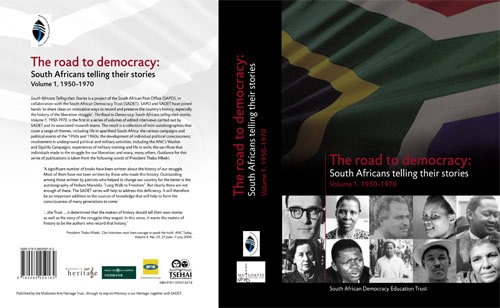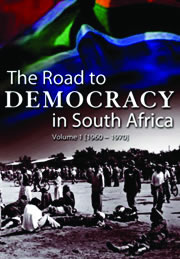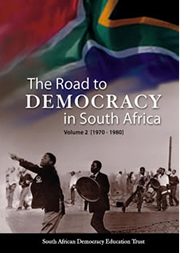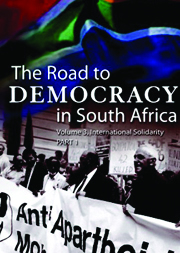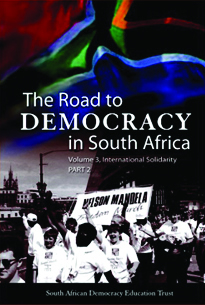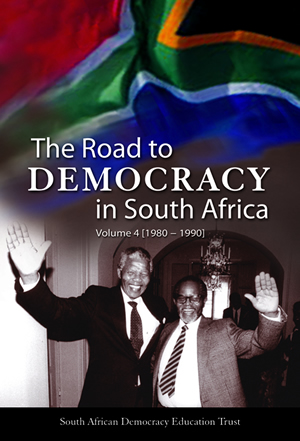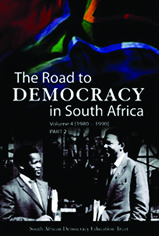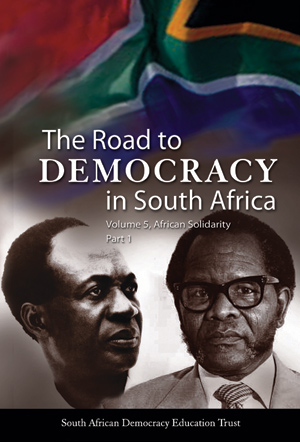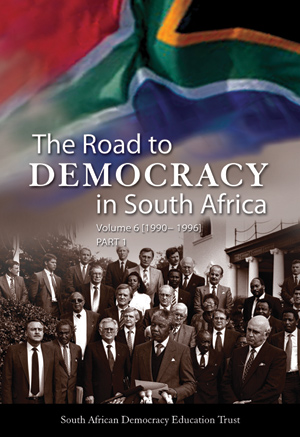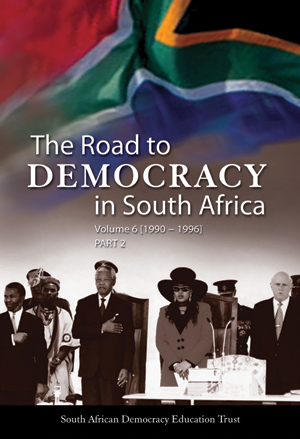The Road to Democracy - SOUTH AFRICANS TELLING THEIR STORIES - Volume 1
South African Democracy Education Trust
CONTENTS (some chapters may be downloaded for further reading ![]() )
)
1. Joe Matthews |
31. Flo Mnumzane
|
Disclaimer
The authors have made every effort to contact all interviewees whose interviews are used in this volume to secure permission for use of their interviews. Any oversight is regretted.
PREFACE
1. Genesis
South Africans Telling their Stories is a project of the South African Post Office (SAPO), in collaboration with the South African Democracy Trust (SADET). SAPO and SADET have joined hands 'to share ideas on innovative ways to record and preserve the country's history, especially the history of the liberation struggle'. Since there are other related initiatives, 'the project will focus on ordinary South Africans telling their own stories'.
SAPO initiated the SAPO History Project under the working theme: South Africans Telling Their Stories with the aim of creating a platform for ordinary South Africans to tell stories about their experiences under segregation and apartheid, including their individual or collective contribution to the liberation struggle. SADET's Oral History Project has led to a vast collection of interviews of South Africans that SADET has made available to be included in the series, along with personnel to assist edit the interviews and volumes. Collaboration between SAPO and SADET will result in a series of accounts, in several volumes, based on interviews with, and articles submitted by, a wide variety of South Africans.
2. Objectives
The project's primary objective is to encourage South Africans from all walks of life, with due regard to inclusiveness, to tell their stories - not only as passive spectators or victims and perpetrators but also as actors and makers of history in their own right. The emphasis is on human agency, on individual and collective efforts, on the multi-pronged approach that characterised the liberation struggle. The accounts breathe life into historical discourse by telling 'more of the truth than the historian's truth', from the perspective of ordinary South Africans giving a sense of what it felt like to live through identified periods.
A secondary objective is to provide complementary reading material to academic volumes on The Road to Democracy in South Africa, a SADET project established after President Thabo Mbeki expressed concern over the paucity of 'witness accounts chronicling the steep and winding road to South Africa's negotiated settlement'. The accounts flesh out so many witness accounts of gross human rights violations told under the auspices of the Truth and Reconciliation Commission, while providing a sense of the irrepressible nature of the human spirit that fuelled human resolve to triumph over exploitation and repression.
As complementary reading to The Road to Democracy, therefore, these accounts provide straightforward narratives to readers for whom the dry facts of history are less palatable than accounts of the same events rendered as auto/biographies. The Road to Democracy is the polemical, analytical volume. The companion volume, South Africans Telling their Stories, consists of narratives as 'witness accounts'.
As rendition of history, therefore, these narratives demonstrate the dynamism of people shaping events and being shaped, in turn, by the events they set in motion. They provide a sense of people as creative fighters and agents of social transformation.
 To top
To top
3. The South African Democracy Education Trust
3.1 Background
The South African Democracy Education Trust (SADET) was established as a project Trust after President Thabo Mbeki indicated his concern about the paucity of historical material on the arduous and complex road to South Africa's peaceful political settlement after decades of violent conflict. Following discussions with the private sector, core funding for SADET was provided by MTN and the Nedbank Group.
In 2004 MTN became the leading sponsor of the project, while the National Lottery Distribution Trust Fund gave SADET a grant to carry out the research. SADET's activities are overseen by a Trust Board, chaired by the Minister in the Presidency, Dr Essop Pahad, and includes Minister Lindiwe Sisulu, Dr Meshack Khosa of MTN (replacing Dr Yvonne Muthien in 2005), Adv. Selby Baqwa (SC) of the Nedbank Group, General A. Masondo (retired Chief of Service Corps, South African National Defence Force), Mr Isaac Makopo of the MK Veteran's Association, Mr Seth Phalatse, Dr Vincent Maphai, Dr Eddy Maloka, and Professor Bernard Magubane (SADET). A project management and research team was established, and consisted of Professor Bernard Magubane (Project Leader), Dr Gregory Houston (Project Coordinator), Dr Sifiso Ndlovu (Senior Researcher) and Mrs Elsa Kruger (Project Administrator). In 2004 Dr Houston was appointed Executive Director and Professor Magubane Editor-in-Chief.
3.2 Mission
SADET's mission is to examine and analyse events leading to the negotiated settlement and democracy in South Africa with a focus on:
-
the events leading to the banning of the liberation movements;
-
the various strategies and tactics adopted in pursuit of the democratic struggle;
-
the events leading to the adoption of the negotiation strategy; and
-
the dynamics underpinning the negotiations process between 1990 and 1994.
The study will result in, among others, the publication of 5 volumes of research covering the successive decades in the run up to the first democratic elections, including an overview volume.
3.3 Terms of reference
The Road to Democracy project is a chronological analysis of four decades - 1960-1970, 1970-1980, 1980-1990, 1990-1994, bearing in mind the four areas of focus above and the following themes for each decade:
-
Political context: the political dynamics of each decade, such as the banning of the liberation movements, the formation of insurgency structures, exile and the containment of resistance in the 1960s.
-
Key organizations and key individuals: the formation, policies and objectives, membership and activities of key organizations during each decade, and the role of key historical, as well as less well-known but significant, actors.
-
Strategy and tactics: the evolution of the strategy and tactics of key organizations, including debates around changing strategies and the impact of adopted strategies and tactics on revolutionary developments.
-
Regime response: the response of the apartheid regime to the activities of the liberation movements, including changes in the nature of the apartheid state, the evolution of policies to contain resistance, and repression and counter-revolutionary strategy.
-
International context: the role of the international community in the liberation of South Africa and international events and processes that impacted on the liberation struggle.
-
Regional context: regional events and processes that had an impact on the liberation struggle and the decision to adopt a negotiation strategy and studies of provincial and local involvement in the liberation struggle.
-
Outcome: the major outcomes at the end of each decade.
3.4 Methodology
The banning of the liberation movements in 1960 and the subsequent turn to armed struggle led to a dramatic change in the lives of millions of South Africans. Participation in the sabotage campaign and other underground activities, exile, military training and action, imprisonment, death in detention, banishment, constant surveillance and harassment, and general involvement in the struggle against apartheid characterized the lives of many of our people for the next thirty years. Their experiences form part of the tapestry of our country's history. Chronicling this history is a major task, and a serious responsibility that has been given to SADET.
In line with the goal of making this a truly South African project and with drawing in as many people as possible into the project, research teams, including both senior researchers and research assistants, were drawn from the Africa Institute of South Africa, the Wits History Workshop, the Human Sciences Research Council, and the Universities of the Western Cape, Free State, the Witwatersrand, Cape Town, Rhodes, Fort Hare, Transkei, North-West, and KwaZulu-Natal. The individuals in these research teams and the SADET team conducted the interviews appearing in this volume. They are Jabulani Sithole, Brown Maaba, Siphamandla Zondi, Noor Nieftagodien, Candy Malherbe, Patt Gibbs, Joyce Sikhakhane, Nhanhla Ndebele, Moses Ralinala, Thozama April, Sello Mathabatha, Edward Rapao, Sean Morrow, Bernard Magubane, Sifiso Ndlovu and Gregory Houston. Only a small selection of the hundreds of interviews that have been conducted since September 2000, when SADET began operating, have been included in this volume.
SADET's Board members have played a central role in providing intellectual guidance in the preparation of the volume by overseeing the process from SADET's initial involvement with SAPO to reviewing drafts of the manuscript from time to time. This was in addition to the normal task they play of providing support and guidance to the SADET management team. The latter include soliciting funds for the organisation and for it's various specialised tasks, reviewing and directing the use of the organisations' funds, reviewing research reports, discussing new SADET projects and facilitating their implementation.
 To top
To top
4. Periodisation
South Africans Telling their Stories will appear initially in four volumes. The four periods as described below correspond to those identified for each SADET volume of The Road to Democracy in South Africa and provide the organising principles and the central themes of each volume.
4.1 Sharpeville and its Aftermath
The anti-pass demonstrations on 21 March, 1960, which led to the Sharpeville shootings, precipitated an unprecedented crisis in 20th century African politics in South Africa, when the African National Congress (ANC) and the Pan Africanist Congress (PAC) were outlawed on 8 April, 1960. The future began to look increasingly bleak, exacerbated by the Rivonia Trial that ended with life sentences being passed on 11 July, 1964, on Nelson Mandela, Walter Sisulu, Govan Mbeki, Raymond Mhlaba, Elias Motsoaledi, Andrew Mlangeni, Ahmed Kathrada and Dennis Goldberg. Harassment of suspected political activists continued unabated in the form of random detentions, banning orders, house arrests, banishment, deaths in detention, and capital punishment. Community leaders who escaped the extensive dragnet cast by the state either went underground or left to operate from abroad. Many others suffered burn-out or caved in. A palpable culture of fear emerged in the aftermath of Sharpeville to paralyse extra-parliamentary resistance politics.
The state became as dreaded as izimu or ledimo, the monster of traditional folklore, as South Africa descended into a garrison state. The ubiquitous impimpi lurked behind every closed door or window, restricting political discussion and constraining every political impulse. An illusion of safety, stability, and prosperity for white South African society developed that hid the simmering tension beneath the deceptively placid surface. As the narratives demonstrate, political activity in opposition to apartheid took place underground. Open political activity outside the framework of government-sanctioned structures did not resurface until the late 1960s. However, the background to the 1960s are to be found in a number of significant events of the 1950s, such as the banning of the Communist Party of South Africa (CPSA), the 1952 Defiance Campaign, the Congress of the People, and the Treason Trial. Recollections of these events are included in volume 1.
4.2 From the Black Consciousness to the Soweto Era
The resurgence of radical politics came from an unlikely source - a generation of university students who had been socialised from their first day at school under Bantu education, a system of education for servitude designed for Africans and first introduced in schools in 1954. This was also a generation that was, on the whole, too young to have felt and experienced first-hand the cowering effect of repression after Sharpeville. The rise and spread of Black Consciousness in South Africa is best understood in the context of the deepening crisis under apartheid, as it filtered down and began to affect this new generation of blacks that had to devise new strategies to cope with their existential situation. With diminishing intellectual, political and historical resources in their communities, to whom they could turn for nurturing and sustenance, they wrote the script as they went along.
Black Consciousness grew as a set of strategies, some knee-jerk perhaps but generally closely in tune with popular needs, particularly those of black students in the late 1960s and in the 1970s. The Soweto uprising marked the high water mark of the Black Consciousness era, bringing to the fore an even younger generation of elementary and secondary school activists who would invigorate the liberation movement, further demonstrating the indomitable nature of the human spirit. These struggles complemented the resurgence of worker militancy and continued insurgency by underground operatives of the outlawed organisations, now invigorated by a new and younger generation.
4.3 From the UDF to the unbanning of political organisation
The 19 October, 1977, bans on Black Consciousness organisations were intended to intimidate, if not obliterate, individuals and structures opposed to apartheid, in the same way as the banning of the ANC and PAC had done. Following a brief interregnum, however, the liberation struggle metamorphosed and re-emerged in the more potent form of the United Democratic Front (UDF). As the changing dynamics on the political front in the 1980s once again called for new strategies, the near-hegemonic hold on public expressions of radical politics that the Black Consciousness Movement had exercised in the 1970s began to yield its pride of place to a resurgence of the non-racial tradition more closely associated with the Congress Alliance. The release in November 1989 of most of the Rivonia Trial prisoners, followed by the release of Nelson Mandela in February 1990, marked effective capitulation by the apartheid regime, eventually culminating in the Convention for a Democratic South Africa (CODESA).
4.4 The CODESA Era
The Convention for a Democratic South Africa that began on 21 December 1991 was the last lap on the road to democracy. In some respects, the years 1991-1994 became a test of wills in which the people's resilient culture triumphed over an apartheid culture that had become moribund. South Africans managed to pull themselves - some say 'miraculously' - from the brink of certain disaster. The darkest hour before dawn accompanied the CODESA talks, with vicious state and anarchic forces and their proxies unleashed on mutilated and defenceless people that were, nonetheless, schooled in the art of sacrifice and struggle.
The most dramatic expression of the new terrorism was the assassination of Chris Hani, which, however, was not enough to stop the people's final canter to the winning post on 27 April, 1994. The ushering in of the new government of national unity, following the first democratic elections of 1994; the adoption of a constitution most herald as among the most liberal in the world; the reconfiguration of the new parameters of our nationhood were to become the hallmarks of the new order. The 1990s began South Africa's quest in earnest for reconciliation and reconstruction. How South Africans coped with the politics of transition and the 'second generation' of struggles is instructive of the agony and the ecstasy of the new order wherein, in Anton Gramsci's words, 'the old is dying but the new cannot yet be born.'
5. Choice Criteria
South Africans Telling their Stories is based on the interviews done for the SADET Oral History Project. Our major selection criteria from several interviews with the narrators have been (i) inner coherence as narrative/s or the existence of a distinctive story line and (ii) human interest element infused into recounted historical events. Our choice is based, therefore, on how gripping or otherwise the accounts read as narratives - that is, on how well they work as stories rather than as catalogues of political events.
There are considerable overlaps in the narratives. For example, there are several accounts of imprisonment on Robben Island, describing the same phenomena e.g. Hodoshe span and work in the quarry (e.g. Andrew Masondo, Johnson Mlambo); of travels to Tanganyika, Egypt, Algeria etc.; and of MK activities e.g. military training in the Soviet Union, life at the Kongwa camp, the Wankie Campaign, etc. There are also several accounts of the same event e.g. the Morogoro Conference.
We avoid repeating accounts of the same event each time, except where each adds value by offering a different perspective or dealing with what the other account/s omit. Our selection, where there are inevitable overlaps, has been based on 'added value'. For example, Isaac Maphoto provides an account of Sipolilo, where Mongameli Tshali deals with Wankie, although in other respects both cover similar ground, especially regarding the journey through Botswana to Tanzania. Similarly, Isaac Makopo provides an account of training in Moscow, where Isaac Maphoto deals with training in Odessa. We have left out some stories, therefore, and selected others on the basis of (i) how graphic or otherwise the descriptions are and (ii) whether they are first-hand accounts or not.
As the SAPO/SADET project's primary objective is 'to encourage
South Africans from all walks of life to tell their stories', we
have tried to maintain some sense of balance and pay due regard
to inclusiveness and representation demographically in terms of
gender, region, race and class.
The general purpose is to avoid one-sidedness in historical representation
that off-sets efforts to correct distortions of the past by creating
new distortions in the opposite direction. We attempt to reflect
the complete picture or reality of a struggle that was inclusive,
involving South Africans from every region and of every hue, class
and gender.
6. Narrators and Scope
With one or two exceptions where the cut-off might have been too abrupt, the narratives do not go beyond the 1960s. As far as possible, therefore, and, as with Volume 1 of The Road to Democracy in South Africa, we make 1970 the cut-off point for Volume 1.
We may also want to revisit some of the accounts and interviews selected for Volume 1 in subsequent volumes to document the continuing role of some of these veterans in the struggle, along with the contribution of 'new comers'.
Not everyone joined MK, or served a prison sentence on Robben Island, or lived in exile.
To cite Joe Matthews:
You have to combine the struggle of the people, internally, the struggle of the people in prison, the struggle of the people in exile and then the international solidarity movement. You have to put all those together, as Lenin would put it, a combination of legal and illegal struggle without which a revolutionary victory is impossible. So we have to get all the various aspects of struggle and indicate the role they played and then make the point that all of us, individually and collectively, each one made a contribution, so there's no question of one or two or three individuals.
The project is about, in Brenda Marshall's words, 'histories forgotten, hidden, invisible, considered unimportant, changed, eradicated'.
About Us | Road to Democracy | Gallery | Sponsers | Contact | Interviews | Home
© 2015 SADET - All Rights Reserved


